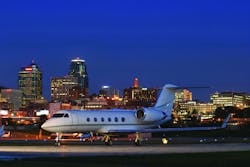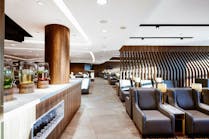Kansas City - Nestled in a nook of the Missouri River just accross from Kansas City's downtown business center, Charles B. Wheeler Downtown Airport (once Richards Field) is considered by some to be the original home to commercial aviation. In fact, Charles Lindberg dedicated the airport in 1927, and it was also headquarters for Trans World Airlines (TWA) beginning in 1931; Howard Hughes' original office has remained in tact in what is now a Signature Flight Support terminal facility.
Renamed for former mayor Charles Wheeler, the airport is now primarily used for corporate and recreational aviation. Aging infrastructure and aircraft storage units had been driving business to outlying relievers for years.
The department of aviation began a refurbishment program in 2005; a program that juxtaposes the city's efforts to revitalize the downtown district.
Comments director of aviation Mark VanLoh, "We knew what we had to do here … we knew we had to get those pilots back that had left over the years; they had scattered like the wind. Those runways hadn’t been touched since Howard Hughes was here running TWA."
Airport manager Michael Roper agrees. "We just didn’t have anything to offer our tenants," he says. "We are the largest GA airport in the greater Kansas City area, but every other airport had more T-hangars than us; we knew we were not serving our market."
"We chipped away at it, and $70 million later it’s done," explains VanLoh. "Of course we began all of this and the downturn hits; it’s slowly coming back. The hangars are filling up and we are making money."
Furthermore, the airport has added the new aviation services company, Hangar Ten, to the field. Featuring a large executive hangar and upscale terminal facility, Hangar Ten was designed by Atlanta-based Dye Aviation Facilites, Inc, and was recently recongized by Aviation International News as a top-rated facility in this year's annual FBO survey.
Critical airport improvements
The Downtown Airport's (MKC) refurbishment program included a $28 million project to resurface both airport runways, a 96-unit hangar project, the construction of a 3,200-square foot general aviation terminal, the addition of a self-serve 100LL fuel farm and station, and an aircraft wash.
"We are predominately a business aviation airport; 85 percent of operations here is business related," remarks Roper.
With the billions of dollars that were invested in the redevelopment of the downtown area, a lot of young professionals are coming into the city, he adds. It was time to build, and reinvigorate, says Roper. "We asked our tenants what they wanted, and tried to meet their needs."
Currently there are some 230 aircraft based here total; 45 of them are jets. Aircraft storage was a key component of the refurbishment program. The airport invested some $20 million in hangar development, building 96 units in seven buildings; the total square footage of hangar space is now 139,828 square feet.
"We did the best market research we could when it came to the hangar development," relates Roper. The airport utilized a mix of three different sizes for the hangar development: 12 box hangars, 21 large T-Hangars, and 63 small T-Hangars; all hangars are Erect-A-Tube products.
The hangaring business is doing well, says Roper, and the airport is already looking to develop more.
Business environment
"We averaged between 92 and 94 percent hangar occupancy throughout the recession," relates Roper. "On top of that, we didn’t lose any aircraft. That’s an interesting statistic for us; in fact, we gained some aircraft. With the new hangars, we have been growing our base.
"So we are sitting here with the best numbers of based aircraft that we’ve had in decades. Operations took a hit during the downturn because the planes weren’t flying as much, but things are improving and business is slowly coming back."
Roper is optimistic, and the only real concern he has is with regard to the price of fuel. "It’s not just the direct operating cost of the aircraft, it’s what the fuel prices do to the economy," he says.
"Business aviation is going to grow. If fuel can stabilize, we’ll see business aviation here back to what it was before the recession."
With regard to the new self-fueling system, Roper says he is very happy with the decision to add it to the field; the airport's first year of fuel sales exceeded expectations by more than 10 percent. "It’s performing way beyond our projections; that’s probably one of the best things we ever did is build our own fuel farm," adds VanLoh.
"We now have pilots returning. There’s something to be said about having a control tower operational 24-hours, crash/fire rescue, and knowing the airport is going to stay open in snow. We knew once we got a roof over their heads, they’d be back.
"We’re in the economic development game just like every city; the location of the airport right downtown is a major draw for a lot of companies."
On the Hangar Ten development, VanLoh says he doesn't have minimum standards for FBOs on the field. Signature Flight Support (formerly Executive Beechcraft) has always been the sole fuel provider at MKC.
"When we first thought about the competition that would occur between Hangar Ten and Signature, we thought we know it’s going to lower fuel prices," explains VanLoh. "But what is it going to do to the fuel sales of Signature? Low and behold, Hangar Ten is actually attracting more new customers to downtown; pure fuel competition is what it is."
Hangar Ten: The Business Model
Opened last October, features of the new Hangar Ten complex include a 28,000 square foot terminal facility complete with overnight rooms each with a private bath/shower, entertainment center, and fold-down bed; a fully-equipped fitness center; meeting and conference rooms; customer and pilot lounges; gourmet catering; and more.
The 29,000 square foot executive hangar can fit a G650 and features sustainable design aspects.
Says general manager Brad Chandler, "Since May of ’09 there’s been 11 new jet aircraft added to this field. We’ve attracted some people from Kansas; we’ve had a lot of new aircraft purchased.
"A lot of our business comes from either new operators, or operators moving from somewhere else, or aircraft added by our based customers.
"A big part of our goal is to increase the overall volume at the airport, whether through based customers or transients."
The marketing approach is very much word of mouth, relates Chandler. "What we’ve really tried to avoid is using fees to leverage fuel purchases," he says. "The question comes up … what’s your ramp fee? Well we don’t have ramp fees, or handling fees … we have a facility charge, but we’d really much rather earn your courtesy fuel business.
"That’s the approach we’ve taken, and we’ve tracked it … we’ve looked at our courtesy fuel loads and they are well above on average what we would’ve implemented on a mandatory basis.
"Our hangar prices are based on the square footage of the plane and the volume of the fuel you buy; your fuel price is based on the volume of fuel your fleet buys, period.
"From a customer service standpoint, we’ve tried to identify all of the small things; we want to get those small things right every time. The chocks are big to us, opening doors are big to us, fresh, quality food is big to us."
Owner and CEO Jim Stowers says the flight activity Hangar Ten supports is all GA and mainly turbine. "Our hangar and office build are more than 100 percent full at this time; we have plans to continue expansion in late summer." The expansion will include another 22,000-square feet of hangar space and a 17,000 square foot terminal building.
With regard to business today, Stowers comments, "We are feeling more optimistic every day. Nationwide we are seeing an increase in traffic at GA facilities. Our ramp is very active and we see a continued increase in private travel due to many factors; continued security concerns, delays with TSA, continued and growing demand for travel to specific sites not served by commercial carriers all help us achieve our business model."
Hangar Ten: Design and Construction
Dye Aviation, a design and construction management firm, has been primarily designing general aviation support facilities, corporate flight departments, FBOs, and MROs For the last 20 years.
Remarks president Mercer Dye, "The Hangar Ten project was a lot of fun. It was a bit unusual in that it was a single entrepreneur who saw a need at his own airport.
"It was the toughest site I’ve ever worked on; it kind of got squeezed from every point of view. We had site-line issues with the tower, so we had to bend the building around. We couldn’t get much repetition of any design component; almost every corner of the place is unique."
According to Dye, Stowers was very interested from the beginning in energy management, and building the facility to be as energy efficient as possible. Daylighting in the terminal (utilization of large amounts of window space) and automated sky and wall lights in the hangar contribute to the sustainability of the complex.
From a functional standpoint,FBO terminal buildings are kind of like designing branch banks, relates Dye. "The adjacency of each function is important. Our starting point was, the more people that have the ability to see the ramp, the safer the place will be. So customer service, line service, passengers, and administrative staff all have a view to the ramp," he says.
"It’s for safety, and it also enables the staff perform the best customer support possible.
With regard to maintanance, Dye commments, "We are very careful about selecting finishing materials in the lobby and public areas, so they can stand the maintenance that the typical terminal requires. So our finishes are cleanable and last a long time; durability does have a cost however, so that has to be balanced."
On the industry as a whole, Dye says that his clients are looking at growth opportunities with a more cautious eye than in the past, and that may be good. He adds, "But clearly, new hangar development and new terminal building development is significantly slower than what it’s been."





